Draft Practical Compliance Guideline
PCG 2022/D1 (Finalised)
Section 100A reimbursement agreements - ATO compliance approach
-
There is a Compendium for this document: PCG 2022/2EC .This document has been finalised by PCG 2022/2.
| Table of Contents | Paragraph |
|---|---|
| What this draft Guideline is about | |
| Application | |
| Background | |
| Compliance approach | |
| White zone arrangements | |
| Green zone arrangements | |
| Green zone scenario 1 - distribution to individuals: members of a family | |
| Green zone scenario 2 - examples described in TR 2022/D1 as being an ordinary dealing | |
| Green zone scenario 3 - retention of funds by the trustee | |
| Blue zone arrangements | |
| Features of blue zone arrangements involving the retention of funds by the trustees | |
| Red zone arrangements | |
| Red zone scenario 1 - arrangements where the presently entitled beneficiary lends or gifts some of all of their entitlement to another party | |
| Red zone scenario 2 - arrangements where trust income is returned to the trust by the beneficiary in the form of assessable income | |
| Red zone scenario 3 - arrangements where the presently entitled beneficiary is issued units by the trustee (or related trust) and the amount owed for the units is set-off against the beneficiary's entitlement | |
| Red zone scenario 4 - arrangements where the share of net income included in a beneficiary's assessable income is significantly more than the beneficiary's entitlement | |
| Red zone scenario 5 - arrangements where the presently entitled beneficiary has losses | |
| Red zone scenario 6 - arrangements subject to a Taxpayer Alert | |
| Date of effect | |
| Appendix - Examples | |
| Example 1 - arrangement ceased before 1 July 2014 | |
| Example 2 - use of funds condition and part payment of unpaid present entitlement | |
| Example 3 - use of funds condition and unpaid present entitlement | |
| Example 4 - trustee retains funds and services loan agreement | |
| Example 5 - funds used for family purposes | |
| Example 6 - distributions from a family business | |
| Example 7 - amounts provided to the parent in respect of expenses incurred before the beneficiary turns 18 years of age | |
| Example 8 - non-resident beneficiary makes a loan or gift to an associate | |
| Example 9 - the presently entitled beneficiary is issued units by the trustee (or related trust) and the amount owed for the units is set-off against the beneficiary's entitlement | |
| Example 10 - the share of net income included in a beneficiary's assessable income is significantly more than the beneficiary's entitlement | |
| Example 11 - the presently entitled beneficiary has losses | |
| Your comments |
|
Relying on this draft Guideline
This Practical Compliance Guideline is a draft for consultation purposes only. When the final Guideline issues, it will have the following preamble: This Practical Compliance Guideline sets out a practical administration approach to assist taxpayers in complying with relevant tax laws. Provided you follow this Guideline in good faith, the Commissioner will administer the law in accordance with this approach. |
What this draft Guideline is about
1. The use of trusts as business and investment vehicles in Australia is common. The scope of arrangements involving trust distributions for which section 100A of the Income Tax Assessment Act 1936 (ITAA 1936)[1] may be relevant is also broad. We therefore recognise the importance of explaining our compliance approach when considering the application of section 100A.
2. Broadly, section 100A does not apply to a trust distribution unless there is a related payment or other benefit provided to a person other than the beneficiary. For trust entitlements of beneficiaries under 18 years of age or otherwise under a legal disability, section 100A has no application.
3. This draft Guideline[2] sets out how the ATO differentiates risk for a range of trust arrangements to which section 100A might apply and how we tailor our engagement. In doing so, it also provides more certainty to taxpayers and their advisers to:
- •
- assess the level of risk regarding your trust distribution arrangements based on the risk framework
- •
- determine the level of engagement you can expect from us
- •
- decide whether to contact us to discuss how you may reduce the risk profile of your arrangement.
4. This Guideline denotes the different risk ratings according to four coloured zones. The table at paragraph 12 of this Guideline summarises each of these zones and the corresponding compliance approach. The Appendix to this Guideline contains examples that illustrate the application of the different risk zones.
5. This Guideline is designed to give you confidence that, if your circumstances align with the low-risk ratings set out in this Guideline, we will generally not allocate compliance resources to test the tax outcomes of your arrangement.
6. We are continuing work to identify taxpayers who wish to nominate themselves as a test case to obtain further judicial guidance.
7. This Guideline will be updated from time to time to reflect modifications to our risk framework as our understanding of various arrangements and views on section 100A continue to evolve.
8. This Guideline describes our compliance approach to section 100A. The information provided in this Guideline does not replace, alter or affect the ATO's interpretation of the law in any way. It complements, and should be read together with, draft Taxation Ruling TR 2022/D1 Income tax: section 100A reimbursement agreements which sets out the ATO's interpretative position on the application of section 100A.
9. Where a beneficiary's present entitlement has arisen under a reimbursement agreement, that present entitlement is disregarded for the purposes of the ITAA 1936 and the Income Tax Assessment Act 1997, and the trustee is made liable to tax at the highest marginal rate in relation to the share of trust net income associated with that amount. One element of the definition of a reimbursement agreement is that the entitlement has arisen under an agreement, arrangement or understanding that provides for a payment or benefit to another person.[3]
10. However, an agreement is not a reimbursement agreement where it has been entered into in the course of ordinary family or commercial dealing.[4] The Commissioner's view in TR 2022/D1 is that there is ordinary family or commercial dealing where the acts by which the dealing has been implemented are capable of explanation by the regular familial or commercial objects those acts are apt to achieve, and do not demonstrate a purpose of tax avoidance.[5] It is an evaluative standard that is to be applied to the facts of each case.
11. An agreement that includes the creation of a present entitlement to funds that are retained by a trustee will satisfy the basic elements of the definition of a reimbursement agreement, as it will involve a present entitlement and the provision of a benefit to the trustee. Consequently, it is necessary to test whether such an agreement meets the other elements of a reimbursement agreement, including whether it was not entered into in the course of ordinary family or commercial dealing, in which case it is not a reimbursement agreement.[6] This test is applied against a background which acknowledges that it is regular for the controllers of an entity that conducts income-earning activities to re-invest in that entity so that it can derive further income.
12. The following table describes our compliance approach for arrangements to which section 100A might apply:
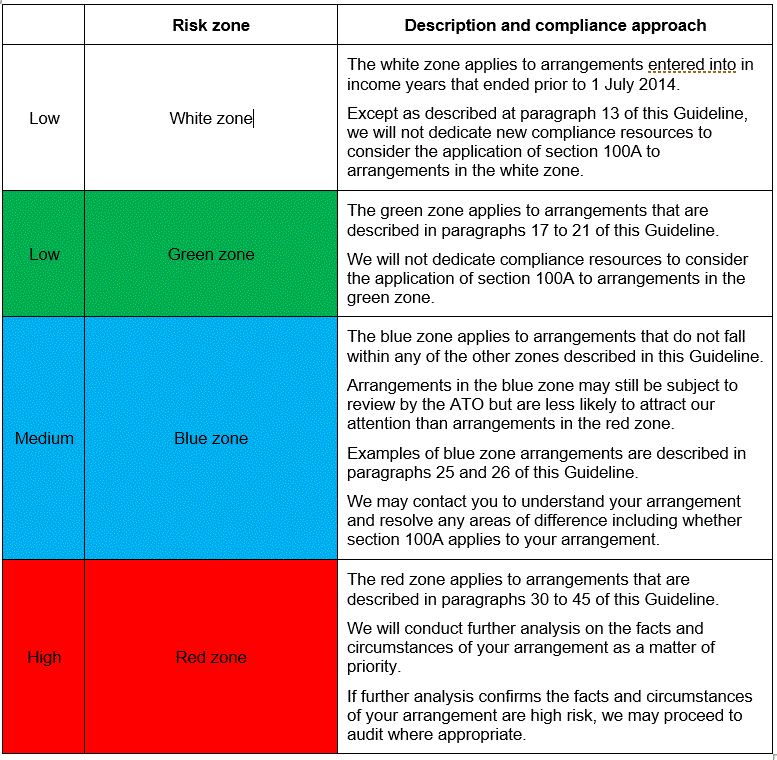

13. We will not commence any new compliance activities to consider the application of section 100A for income years ended before 1 July 2014, unless it is outside the green zone and:
- •
- we are otherwise considering your income tax affairs for those years
- •
- you have entered into an arrangement that continues before and after that date, or
- •
- the trust and beneficiary tax returns that were required to be lodged for those years were not lodged before 1 July 2017.
14. See Example 1 in the Appendix of this Guideline.

15. We will not dedicate compliance resources to consider the application of section 100A to green zone arrangements, other than to confirm that the features of the relevant scenario are present in your circumstances. If you choose to rely on this Guideline, you should document how your circumstances meet the requirements for the green zone.
16. All green zone examples assume that there are no additional features present that may move the example into the blue or red zone.
Green zone scenario 1 - distribution to individuals: members of a family
17. An individual beneficiary is made presently entitled to income of the trust estate and the funds paid to the beneficiary:
- •
- are mixed with their spouse's funds (for example, paid to a joint bank account) or used for joint family purposes, and/or
- •
- benefit a person who is a dependant of the beneficiary.
18. Diagrams 1 and 2 of this Guideline illustrate circumstances within the scope of this scenario.
Diagram 1
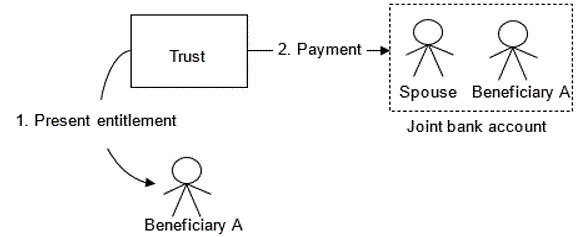
Diagram 2
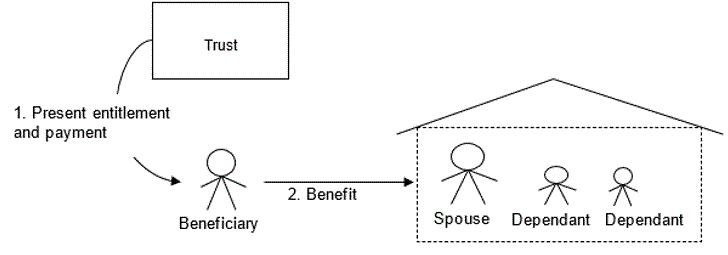
Green zone scenario 2 - examples described in TR 2022/D1 as being an ordinary dealing
19. Arrangements that are relevantly identical to an example in TR 2022/D1 which concludes that the arrangement would likely be entered into in the course of ordinary family or commercial dealing.
Green zone scenario 3 - retention of funds by the trustee
20. A beneficiary that is an individual or a private company is made presently entitled to income of the trust estate and there is a 'trustee retention of funds'[7] where all of the following is satisfied:
- •
- the 'use of funds condition'[8]
- •
- none of the factors set out in paragraph 26 of this Guideline are present
- •
- if that beneficiary is an individual, either
- -
- the individual and/or their spouse is a trustee of the trust or controls the trustee of the trust
- -
- the individual is employed in the management of a business that the trustee conducts
- •
- if that beneficiary is a private company
- -
- the company is controlled by an individual who also controls the trust, and
- -
- the company's entitlement is made available to the trustee on terms that satisfy section 109N.[9]
21. For the purposes of this scenario:
- (a)
- 'Trustee retention of funds' refers to the beneficiary allowing the trustee to retain funds for a period of time or indefinitely that they would otherwise receive in satisfaction of their entitlement. This could be in the form of lending the funds representing their entitlement back to the trustee, or by not yet calling for that entitlement to be satisfied.
- (b)
- The 'use of funds condition' means that the trustee, as permitted by the trust deed, uses the funds (in its capacity as trustee) that represent the beneficiary's entitlement only[10]
- (i)
- in the working capital of a business that it actively carries on
- (ii)
- for the acquisition, maintenance or improvement of investment assets of the trustee, and/or
- (iii)
- to lend the funds to an associate, on terms that satisfy section 109N, and the associate uses the funds in a way that satisfies either of the criteria above.
- (c)
- The use of funds condition is not satisfied if any associate of the trust benefits[11], except as described at paragraph 21(b)(iii) of this Guideline, from that use of funds (for example, being able to use a trust asset for less than market value consideration).
22. Diagrams 3 and 4 of this Guideline illustrate circumstances within the scope of this scenario.
Diagram 3
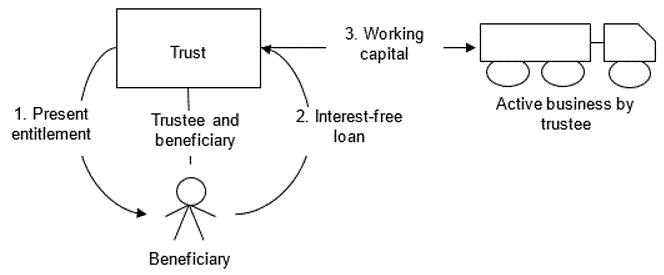
Diagram 4
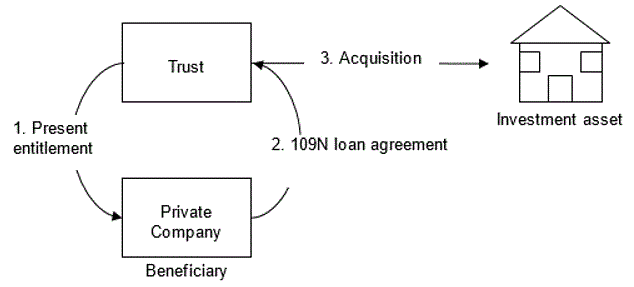
23. Examples 2 to 6 in the Appendix of this Guideline illustrates the scenarios that are green zone arrangements.

24. We may review arrangements in the blue zone and seek to better understand these arrangements including whether section 100A applies.
Features of blue zone arrangements involving the retention of funds by the trustees
25. Arrangements that do not fall within the white zone, green zone or the red zone are in the blue zone.
26. Arrangements involving the retention of funds by the trustees are not in the green zone if they have one or more of the following features:
- •
- The arrangement is a red zone arrangement (see paragraphs 30 to 45 of this Guideline).
- •
- The beneficiary makes a gift of their trust entitlement or an associated amount receivable from the trust (for example, if the unpaid present entitlement was converted into a loan).
- •
- The beneficiary disclaims their entitlement or forgives or releases the trustee from its obligation to pay their trust entitlement or an associated amount receivable from the trust.
- •
- The income of the trust estate[12] is less than the net income as a result of the trustee exercising a power, or the deed being amended, to affect the quantum of income of the trust estate.
- •
- A beneficiary's trust entitlement is satisfied by payments that are sourced from that beneficiary, or a beneficiary's trust entitlement has been made subject to a loan agreement and the repayments of that loan are sourced from payments or loans from that beneficiary. Examples include
- -
- where a dividend payable by a corporate beneficiary to the trustee is set-off against the amount payable by the trust
- -
- where the trustee issues units in the trust to the beneficiary and the amount owed for the units is set-off against the amount payable by the trust, or
- -
- where the trustee is made entitled to income of another trust that is comprised of franked distributions paid by the beneficiary.
- •
- The arrangement involves one or more features that may be explicable by a tax avoidance purpose.
27. That an arrangement is within the blue zone does not mean that section 100A applies to the arrangement. If you have a blue zone arrangement and are subject to compliance activities, we will engage with you to better understand your arrangement, including whether or not section 100A applies to your arrangement.
28. If you have an arrangement in the blue zone, you may wish to consider possible modifications to the arrangement to reduce its risk profile. You can engage with us by emailing ReimbursementAgreement@ato.gov.au to assist with determining what (if any) modifications to your arrangement may be appropriate.

29. Red zone arrangements attract our attention and we will dedicate compliance resources to consider the application of section 100A.
30. Red zone arrangements are those where the:
- •
- beneficiaries' entitlements appear to be motivated by sheltering the trust's (taxable) net income from higher rates of tax
- •
- arrangement involves contrived elements directed at enabling someone other than the presently entitled beneficiary to have use and enjoyment of the economic benefits referable to the trust net income.
Red zone scenario 1 - arrangements where the presently entitled beneficiary lends or gifts some or all of their entitlement to another party
31. An individual adult beneficiary is made presently entitled to income of the trust estate and any of the following apply:
- •
- funds that represent the entitlement are paid to the parent or other caregiver of the beneficiary in connection with expenses incurred by the parent or the caregiver before the beneficiary turned 18 years of age
- •
- the trustee applies the funds that represent the entitlement against a debit balance account for the beneficiary (for example, an amount recorded in the trust's accounts as a loan) representing expenses incurred by the trustee in respect of the beneficiary before they turned 18 years of age
- •
- funds that represent the entitlement are made available to the parent or other caregiver of the beneficiary by way of loan or gift
- •
- the beneficiary is a non-resident and the funds that represent the entitlement are made available to another party by way of loan or gift.
32. Examples 7 and 8 in the Appendix of this Guideline illustrate this scenario.
Red zone scenario 2 - arrangements where trust income is returned to the trust by the beneficiary in the form of assessable income
33. A corporate beneficiary is made presently entitled to income of the trust estate, and all of the following features are present:
- •
- The trustee of a trust owns shares in a private company and the company is also a beneficiary of the trust.
- •
- The trustees, or directors of the trustee company, and the directors of the beneficiary company are the same (or related) individuals.
- •
- The trustee resolves to make the company presently entitled to all, or some part of, trust income at the end of year 1.
- •
- The company includes its share of the trust's net income in its assessable income for year 1 and pays tax at the corporate rate.
- •
- The company pays a fully franked dividend to the trustee in year 2, sourced from the trust income, and the dividend forms part of the trust income and net income in year 2.
- •
- The trustee makes the company presently entitled to all, or part of, the trust income at the end of year 2 (which might include the franked distribution).
- •
- The preceding steps are repeated in subsequent years.
34. Diagram 5 of this Guideline illustrates this arrangement.
Diagram 5

35. The arrangement results in the distribution benefitting a party other than the beneficiary (it instead benefits the trustee). The arrangement provides for the payment of income from the trustee to the company on the understanding (implied from the repetition in each income year and their common control) that the company would pay a dividend to the trustee of a corresponding amount (less the tax paid).
36. The agreement is designed to reduce tax that would otherwise be payable had the trustee simply accumulated the income and appears to be driven by tax considerations rather than a commercial purpose.
Red zone scenario 3 - arrangements where the presently entitled beneficiary is issued units by the trustee (or related trust) and the amount owed for the units is set-off against the beneficiary's entitlement
37. A trustee sets off a beneficiary's unpaid present entitlement (UPE) against an amount the trustee is owed by the beneficiary, being the subscription price for the acquisition of units, and any of the following apply:
- •
- the subscription price of the units is greater than their market value (the market value of the units being determined by reference to the rights and obligations attached to the units and the terms of the trust deed)
- •
- the trust deed provides the trustee with a unilateral right to issue new units in satisfaction of a UPE.
38. Example 9 in the Appendix of this Guideline illustrates this scenario.
Red zone scenario 4 - arrangements where the share of net income included in a beneficiary's assessable income is significantly more than the beneficiary's entitlement
39. The amount of trust net income included in a beneficiary's assessable income is significantly more than the beneficiary's entitlements to income from the trust, and all of the following apply:
- •
- the difference between the net income and beneficiary's entitlement is the result of contrivance
- •
- some or all of the amount reflecting that difference has accrued to, or been retained by, an entity other than the presently entitled beneficiary
- •
- the tax paid by the beneficiary on their share of the trust net income is significantly less than the tax that would have been paid by the entity who accrues or retains the amount, had that entity been assessed on that share of net income instead.
40. We will not treat an arrangement as being as the result of a contrivance for the purposes of paragraph 39 of this Guideline where the difference is merely due to franking credits.
41. Example 10 in the Appendix of this Guideline illustrates this scenario.
Red zone scenario 5 - arrangements where the presently entitled beneficiary has losses
42. A beneficiary's taxable income is less than the trust net income included in the beneficiary's assessable income or the beneficiary's net capital gain is less than the beneficiary's share of trust capital gains, and each of the following applies:
- •
- a reasonable person would conclude that the beneficiary was made entitled so the beneficiary's deductions or capital losses could be utilised against the trust net income (including trust capital gains)
- •
- the economic benefit associated with that trust net income is utilised by the trustee or an entity other than the beneficiary.
43. An exception to this would include where the beneficiary's taxable income is less than the beneficiary's share of the trust net income due to a tax depreciation measure.[13]
44. Example 11 in the Appendix of this Guideline illustrates this scenario.
Red zone scenario 6 - arrangements subject to a Taxpayer Alert
45. An arrangement that is the subject of a Taxpayer Alert where the Commissioner expresses a concern that section 100A applies[14] is a red zone arrangement.
46. If you have an arrangement in the red zone, we recommend that you engage with us by emailing ReimbursementAgreement@ato.gov.au .
47. When finalised, this Guideline is proposed to apply to present entitlements to income of a trust estate conferred before or after its date of issue. However, for entitlements conferred before 1 July 2022, the Commissioner will stand by any administrative position reflected in Trust taxation - reimbursement agreement, which was first published on our website in July 2014 to the extent it is more favourable to the taxpayer's circumstances than this Guideline.
Commissioner of Taxation
23 February 2022
Appendix - Examples
Example 1 - arrangement ceased before 1 July 2014
48. Reformed Trust acquires investment assets. X Co is the trustee of the Reformed Trust. Mr X is a beneficiary of the Reformed Trust and the sole director of X Co.
49. In income years ended before 1 July 2014, the Reformed Trust and Mr X entered into arrangements in relation to present entitlements conferred on him which would be red zone arrangements in this Guideline.
50. The Reformed Trust and Mr X changed the nature of their arrangements in relation to present entitlements conferred on Mr X for the 2014-15 income year and more recently. None of the exclusions in paragraph 13 of this Guideline apply.
51. The entitlements conferred in income years before 1 July 2014 are white zone arrangements and we will not dedicate new compliance resources to consider the application of section 100A to them. The risk rating of the arrangement modified in July 2014 would need to be tested separately.
52. Examples 2 to 6 in this Appendix involve Greater Trust, which is a discretionary trust controlled by Ms Great. The trustee of Greater Trust is Greater Pty Ltd (and all references to Greater Pty Ltd are to it acting in that capacity). The director and shareholder of Greater Pty Ltd is Ms Great. The beneficiaries include Ms Great, her spouse Mr Better, their extended family and Good Pty Ltd.
Example 2 - use of funds condition and part payment of unpaid present entitlement
53. Greater Trust carries on a retail business selling homewares.
54. On 30 June 2023, Greater Pty Ltd resolves to appoint 50% of the trust income to Ms Great and to appoint the remaining 50% to Mr Better.
55. Mr Better and Ms Great use some of their trust entitlements for the 2022-23 income year to meet their personal expenses during the 2023-24 income year. The balance of their entitlements remain unpaid and are used to supplement the working capital of the business carried on by Greater Trust.
56. Diagram 6 of this Guideline illustrates the circumstances in this example.
Diagram 6
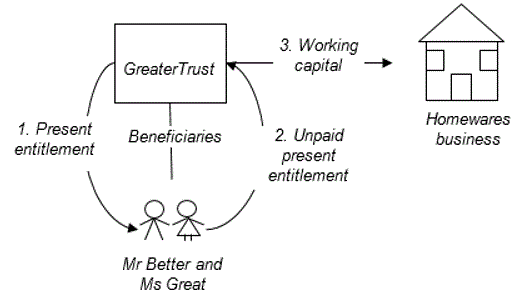
57. Ms Great and Mr Better expect to be paid the remainder of their entitlements but they have no firm plans on the timing of payment. They allow the trustee to use those funds in the homewares business to grow their family's wealth.
58. Funds representing Ms Great and Mr Better's trust entitlements have been either paid to them or retained by the trustee for working capital of the business. The arrangement does not have any features described in the red zone. We would not dedicate compliance resources to this arrangement as it meets the conditions in green zone scenario 3 of this Guideline.
Example 3 - use of funds condition and unpaid present entitlement
59. Greater Trust holds a number of investment assets including shares in listed companies and commercial property from which it derives dividend and rental income respectively.
60. On 30 June 2023, Greater Trust derives income comprised of dividends from listed companies. The income is used to purchase further shares pursuant to dividend reinvestment plans.
61. On 30 June 2023, Greater Pty Ltd resolves to appoint 100% of the trust income to Good Pty Ltd. At the time of appointment, there is an understanding between the parties that Good Pty Ltd will use its entitlement to lend money back to the Greater Trust.
62. During the 2023-24 income year, Greater Pty Ltd enters into an arrangement with Good Pty Ltd that complies with the requirements in section 109N to borrow an amount equal to the funds that Good Pty Ltd is entitled to receive from the Greater Trust.
63. Diagram 7 of this Guideline illustrates the circumstances in this example.
Diagram 7
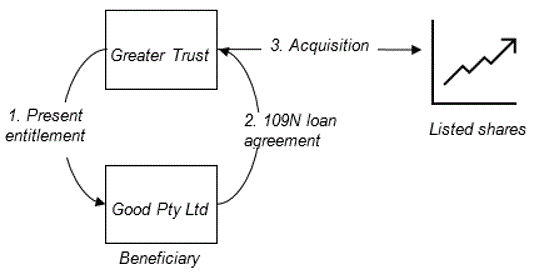
64. During the 2023-24 income year and subsequent income years, Greater Pty Ltd uses trust receipts to meet its obligations under the loan agreement.
65. Funds representing Good Pty Ltd's present entitlement that have been retained satisfy the use of funds condition and a written loan agreement has been entered into on terms that satisfy section 109N. The arrangement does not have any features described in the red zone. We would not dedicate compliance resources to this arrangement as it meets the conditions in green zone scenario 3 of this Guideline.
Example 4 - trustee retains funds and services loan agreement
66. Greater Trust carries on a business as a florist.
67. During the 2022-23 income year, Greater Trust derives income of $100,000 (the trust's net income is also $100,000).
68. On 30 June 2023, Greater Pty Ltd resolves to make Good Pty Ltd presently entitled to all of the income of Greater Trust.
69. Greater Trust partially satisfies the entitlement of Good Pty Ltd to enable it to pay its tax on the $100,000. The balance of the entitlement remains unpaid and is used by the trustee of Greater Trust in funding the working capital of the business. The arrangement amounts to financial accommodation[15] and is, therefore, a loan for the purposes of Division 7A. Greater Pty Ltd and Good Pty Ltd put in place a loan agreement on terms which comply with section 109N.
70. Diagram 8 of this Guideline illustrates the circumstances in this example.
Diagram 8
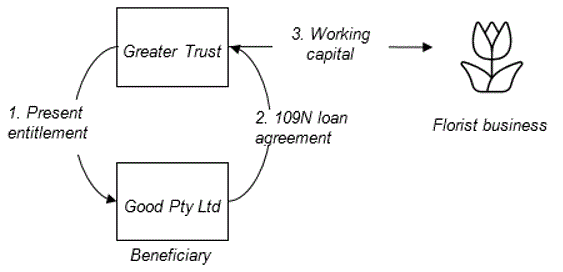
71. Greater Pty Ltd uses the receipts from the trust's business to make interest and principal payments to Good Pty Ltd in fulfilling its obligations in complying with Division 7A.
72. Funds representing Good Pty Ltd's present entitlement have been retained by the trustee for working capital of the business and a written loan agreement has been entered into on terms that satisfy section 109N. The arrangement does not have any features described in the red zone. We would not dedicate compliance resources to this arrangement as it meets the conditions in green zone scenario 3 of this Guideline.
Example 5 - funds used for family purposes
73. Greater Trust holds a number of investment assets.
74. Ms Great and Mr Better have two children, Hubert (aged 15) and Violet (aged 17).
75. On 30 June 2023, the trustee of Greater Trust makes a determination to appoint 50% of the trust income to each of Ms Great and Mr Better. Funds representing the entitlement are paid to a bank account jointly held by Ms Great and Mr Better. The funds are subsequently used for purposes which benefit both of them and their children.
76. Diagram 9 of this Guideline illustrates the circumstances in this example.
Diagram 9
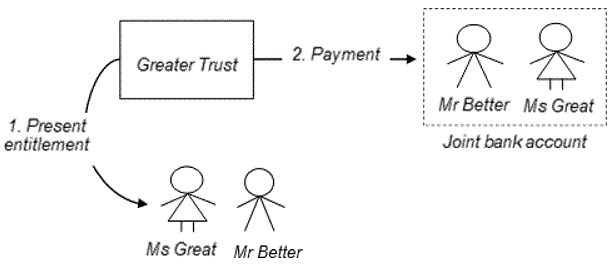
77. We would not dedicate compliance resources to the arrangement in this example, on the basis that it meets the conditions in green zone scenario 1 of this Guideline. The entitlements were used for joint family purposes and to benefit the beneficiaries' dependent children.
78. The facts of this example should be contrasted with red zone scenario 1 and Example 7 of this Guideline, both of which describe when an arrangement involving children of a beneficiary will be high risk.
Example 6 - distributions from a family business
79. Greater Trust carries on a business as a newsagent.
80. Danny is aged 18 and is the daughter of Ms Great.
81. During the 2022-23 income year, Greater Trust derives income of $150,000 (the trust's net income is also $150,000). On 30 June 2023, the trustee of Greater Trust makes a determination to appoint $18,000 to Danny and 50% of the remainder to each of Ms Great and Mr Better.
82. Funds representing Danny's entitlement are paid to her bank account and she subsequently uses them to pay her university fees.
83. Ms Great and Mr Better do not call for their entitlements to be satisfied, and funds representing each of their entitlements are retained by the trustee and used in the working capital of the newsagency business.
84. We would not dedicate compliance resources to the arrangement in this example, on the basis that:
- •
- it meets the conditions in green zone scenario 3 of this Guideline in relation to the unpaid entitlements of Ms Great and Mr Better, and
- •
- Danny enjoys the benefit of her entitlement to trust income.
Example 7 - amounts provided to the parent in respect of expenses incurred before the beneficiary turns 18 years of age
85. Brown Trust's beneficiaries include the members of the Brown Family. Brown Co is the trustee of Brown Trust, and Bronwyn Brown is the sole shareholder and director of the trustee.
86. Bronwyn is the parent of three adult children; Sandra (aged 26), Simon (aged 21) and Sam (aged 19).
87. During the 2022-23 income year, Sandra is self-employed and has a taxable income of $90,000. Simon and Sam study full-time and derive no income during the income year. Bronwyn's children live at home with her at all times throughout the income year.
88. During the 2022-23 income year, Brown Trust derives $240,000 in income (the trust's net income is also $240,000). Throughout that year, Brown Co makes regular payments totalling $240,000 into Bronwyn's bank account. Those payments are recorded as a 'beneficiary loan' in the accounts of Brown Trust. Bronwyn uses these amounts throughout the year to meet her personal living expenses and those of the household.
89. On 30 June 2023, Brown Co resolves to make Simon and Sam each presently entitled to $120,000 of the Brown Trust income.
90. Brown Co applies their entitlements against the beneficiary loan owed by Bronwyn. The entitlements of Simon and Sam are each recorded as having been fully paid in the accounts of Brown Trust. Bronwyn assists in the preparation of Simon and Sam's tax returns and pays the tax liability arising in relation to their entitlements from her personal funds.
91. The entitlements of Simon and Sam are applied in this manner because they each purportedly have an outstanding debt owed to Bronwyn in respect of education expenses and their share of the Brown household expenses that Bronwyn paid before they each turned 18.
92. Diagram 10 of this Guideline illustrates the circumstances in this example.
Diagram 10
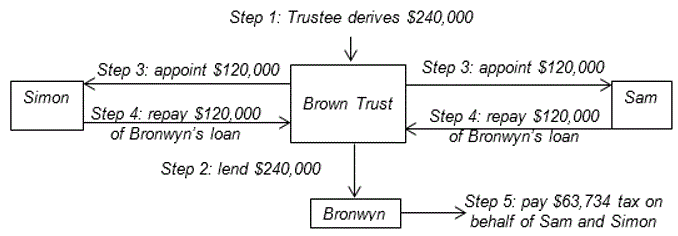
93. On the basis that this arrangement meets the conditions in red zone scenario 1 of this Guideline, we would apply compliance resources in these circumstances.
Example 8 - non-resident beneficiary makes a loan or gift to an associate
94. Orange Trust is a discretionary trust with beneficiaries including the members of the Orange Family. Orange Co is the trustee of Orange Trust, and Thomas Orange is the sole shareholder and director of the trustee.
95. Orange Trust has made a family trust election and Thomas Orange is the specified individual in that election.
96. Thomas is aged 44 and his parents are Sylvia (aged 66) and Sylvester (aged 67). His parents reside outside of Australia and are non-residents for tax purposes.
97. During the 2022-23 income year, Orange Trust derives $400,000 income that is comprised of fully franked dividends. The dividends are paid directly into Thomas' bank account. Thomas uses these amounts to meet his personal expenses and mortgage repayments. The trust income paid into Thomas' bank account is recorded as a 'beneficiary loan' in the accounts of Orange Trust.
98. On 30 June 2023, Orange Co exercises its power to appoint income to make Sylvia and Sylvester each entitled to $200,000 of Orange Trust's income. Orange Trust is not required to pay or withhold tax in respect of the distribution to Sylvia and Sylvester.
99. At the time income is appointed to Sylvia and Sylvester, they have agreed to use their entitlements to lend $400,000 to Thomas on interest-free at-call terms.
100. In the accounts of Orange Trust, Orange Co records that Sylvia's and Sylvester's entitlements are fully satisfied in being applied to repay the $400,000 loan owed by Thomas.
101. Diagram 11 of this Guideline illustrates the circumstances in this example.
Diagram 11

102. On the basis that this arrangement meets the conditions in red zone scenario 1 of this Guideline, we would apply compliance resources in these circumstances.
Example 9 - the presently entitled beneficiary is issued units by the trustee (or related trust) and the amount owed for the units is set-off against the beneficiary's entitlement
103. Johnson Trust is a hybrid trust that carries on a profitable business providing building repair services to the public. Johnson Co is the corporate trustee of Johnson Trust and Lauren Johnson is its sole shareholder and director.
104. Hammer Co is a private company with Lauren Johnson as the sole director and shareholder.
105. As a hybrid trust, Johnson Trust has two classes of beneficiaries. One class is comprised of the unit holders and the second class are the discretionary objects.
106. The terms of the trust deed for Johnson Trust include the following:
- •
- On or before 30 June of a relevant income year, the trustee has the power to appoint income of that year to one or more of the discretionary objects.
- •
- The unit holders are entitled to so much of the income of the trust for a particular income year that the trustee has not appointed to any discretionary object with a unitholder's entitlement being proportional to the number of units they hold.
- •
- Upon vesting of the trust, or earlier where the trustee chooses, the unit holders are entitled to capital of the trust equal to the paid up value of the units.
- •
- The trustee has the discretion to pay the balance of the capital of the trust to one or more discretionary objects of the trust.
107. During the 2022-23 income year, Johnson Trust derives income of $500,000 (the trust's net income is also $500,000) from its business activities. The trust reinvests the net income into its business activities as working capital.
108. On 30 June 2023, Johnson Trust resolves to distribute 100% of the trust income to Hammer Co which is a beneficiary within the class of discretionary objects.
109. On 1 October 2023, the trustee of Johnson Trust exercises its power to issue new units to Hammer Co for $500,000. The accounts of Hammer Co and Johnson Trust recognise a set-off of Hammer Co's $500,000 unpaid present entitlement against the unit subscription amount.
110. As Johnson Trust and Hammer Co treated Hammer Co's unpaid present entitlement as having been satisfied by the issue of new income units, they also do not recognise any associated Division 7A deemed dividends.
111. Diagram 12 of this Guideline illustrates the circumstances in this example.
Diagram 12

112. On the basis that this arrangement meets the conditions in red zone scenario 3 of this Guideline, we would apply compliance resources in these circumstances.
Example 10 - the share of net income included in a beneficiary's assessable income is significantly more than the beneficiary's entitlement
113. Prior to 2023, a private group controlled by Ms Day consists of Operating Trust, Passive Pty Ltd and Holding Trust.
114. Holding Trust is a discretionary trust and the shareholder of Passive Pty Ltd. The deed of Holding Trust defines trust income as being equal to the net income of the trust calculated under section 95.
115. Passive Pty Ltd receives trust distributions from Operating Trust which represent the annual profits from Operating Trust's business. Passive Pty Ltd has retained profits that reflect distributions from Operating Trust over the past five years.
116. Passive Pty Ltd uses its retained profits to make loans to Ms Day.
117. During the 2022-23 income year, the private group undertakes the following steps so that most of the retained profits in Passive Pty Ltd can be distributed to Ms Day:
- •
- The trust deed of Holding Trust is amended so that proceeds from share buy-backs are capital of the trust.
- •
- New Bucket Pty Ltd is created with its shares held by Operating Trust.
- •
- Passive Pty Ltd buys back 90% of its shares held by Holding Trust for $2.8 million, which is treated as a franked distribution for tax law purposes.[16]
- •
- The $2.8 million share buy-back proceeds are a capital receipt of Holding Trust.
- •
- Holding Trust has trust income for the year of $1,000.
- •
- Holding Trust distributes the $1,000 trust income (which does not include the share buy-back dividend) to New Bucket Pty Ltd.
- •
- Holding Trust distributes $2.8 million capital to Ms Day.
118. Operating Trust continues to appoint its trust income to Passive Pty Ltd and there are no other changes to the group structure.
119. The tax outcome regarding the share buy-back is that the assessable income of Holding Trust includes $2.8 million dividends and $1.2 million franking credits. This is included in the assessable income of New Bucket Pty Ltd since it is presently entitled to the entire $1,000 income of Holding Trust. The company obtains no benefit from the share buy-back.
120. The economic outcome regarding the share buy-back is that Holding Trust has received $2.8 million which is ultimately distributed as capital to Ms Day.
121. Diagram 13 of this Guideline illustrates the circumstances in this example.
Diagram 13
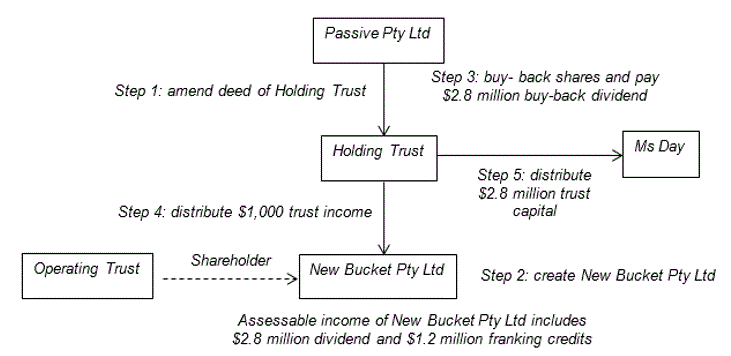
122. On the basis that this arrangement meets the conditions in red zone scenario 4 of this Guideline, we would apply compliance resources in these circumstances.
Example 11 - the presently entitled beneficiary has losses
123. Rouge Trust is controlled by Mr Rouge and has historically distributed to Mr Rouge and his family.
124. During the 2021-22 income year, Mr Rouge meets Ms Loss who has little taxable income and significant tax losses from prior years. They agree that Ms Loss will be made entitled to income of Rouge Trust and that her entitlements will remain unpaid.
125. As Ms Loss is not part of Mr Rouge's family, the trust deed of Rouge Trust is amended to include Ms Loss as a beneficiary of the trust on 1 June 2022.
126. On 30 June 2022, Rouge Trust has $500,000 trust income (the trust's net income is also $500,000) to which Ms Loss is made presently entitled.
127. Ms Loss includes the $500,000 net income of Rouge Trust as assessable income in her tax return for the 2021-22 income year and reports taxable income of nil after applying deductions for prior year tax losses.
128. Ms Loss' entitlement to the $500,000 income of Rouge Trust is unpaid and the money is used by the trustee to make loans to Mr Rouge in lieu of the trust distributions that have historically been made to him and his family.
129. Diagram 14 of this Guideline illustrates the circumstances in this example.
Diagram 14

130. On the basis that this arrangement meets the conditions in red zone scenario 5 of this Guideline, we would apply compliance resources in these circumstances.
Your comments
131. You are invited to comment on this draft Guideline, including the proposed date of effect. Please forward your comments to the contact officer by the due date.
132. A compendium of comments is prepared when finalising this Guideline, and an edited version (names and identifying information removed) may be published to the Legal database on ato.gov.au
Please advise if you do not want your comments included in the edited version of the compendium.
| Due date: | 29 April 2022 |
| Contact officer details have been removed following publication of the final guideline. | |
© AUSTRALIAN TAXATION OFFICE FOR THE COMMONWEALTH OF AUSTRALIA
You are free to copy, adapt, modify, transmit and distribute this material as you wish (but not in any way that suggests the ATO or the Commonwealth endorses you or any of your services or products).
All legislative references in this Guideline are to the ITAA 1936, unless otherwise indicated.
All further references to 'this Guideline' refer to the Guideline as it will read when finalised. Note that this Guideline will not take effect until finalised.
Subsections 100A(1), (2), (7), (11) and (13).
Subsection 100A(13).
Refer to paragraphs 20 to 30 of TR 2022/D1.
There are other elements that, depending on the particular facts of a case, could cause a present entitlement not to have arisen under a reimbursement agreement. See, for example, subsections 100A(5) and (8).
For the purposes of this Guideline, this term has the meaning set out in paragraph 21 of this Guideline.
For the purposes of this Guideline, this term has the meaning set out in paragraph 21 of this Guideline.
A loan, as defined in subsection 109D(3), that is subject to a written agreement which complies with the terms of section 109N.
Incidental use of retained funds, otherwise than in accordance with paragraph 21 of this Guideline, will not prevent an arrangement from satisfying this green zone scenario.
Consistent with the reference in the definition of 'reimbursement agreement' in subsection 100A(7) to '... the payment of money or the transfer of property to, or the provision of services or other benefits for ...'.
Draft Taxation Ruling TR 2012/D1 Income tax: meaning of 'income of the trust estate' in Division 6 of Part III of the Income Tax Assessment Act 1936 and related provisions sets out the Commissioner's view on what amounts can be taken into account in determining the income of a trust estate to which a beneficiary can be presently entitled.
In this Guideline, 'tax depreciation measure' means the temporary full expensing, instant asset write-off and backing business investment measures, and the general depreciation rules.
For example, Taxpayer Alert TA 2016/12 Trust income reduction arrangements.
Draft Taxation Determination TD 2022/D1 Income tax: Division 7A: when will an unpaid present entitlement or amount held on sub-trust become the provision of 'financial accommodation'? sets out the Commissioner's views on application of Division 7A in these circumstances.
On the basis it is an off-market purchase subject to section 159GZZZP.
Not previously issued as a draft.
ATO references: ATO references:NO 1-SGE9MEP
Related Rulings/Determinations:
TD 2022/D1
TR 2012/D1
TR 2022/D1
Legislative References:
ITAA 1936 Div 7A
ITAA 1936 95
ITAA 1936 100A
ITAA 1936 100A(1)
ITAA 1936 100A(2)
ITAA 1936 100A(5)
ITAA 1936 100A(7)
ITAA 1936 100A(8)
ITAA 1936 100A(11)
ITAA 1936 100A(13)
ITAA 1936 109D(3)
ITAA 1936 109N
ITAA 1936 159GZZZP
ITAA 1997
Other References:
Trust taxation - reimbursement agreement
TA 2016/12
